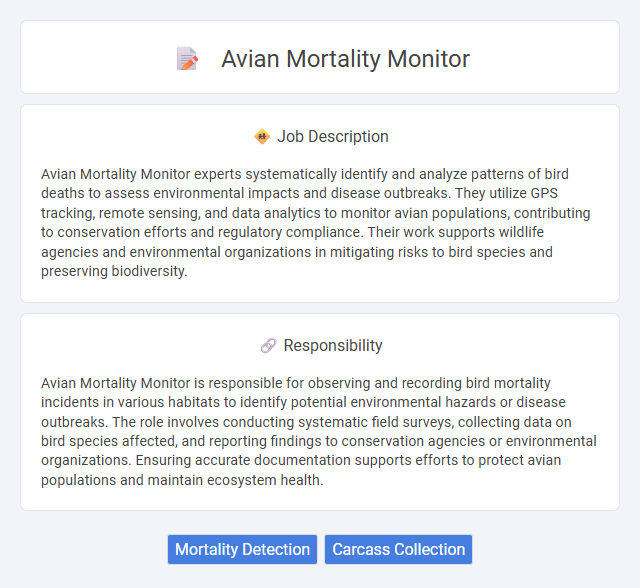
Avian Mortality Monitor experts systematically identify and analyze patterns of bird deaths to assess environmental impacts and disease outbreaks. They utilize GPS tracking, remote sensing, and data analytics to monitor avian populations, contributing to conservation efforts and regulatory compliance. Their work supports wildlife agencies and environmental organizations in mitigating risks to bird species and preserving biodiversity.
Individuals with a strong interest in wildlife and environmental conservation may be well-suited for an Avian Mortality Monitor role, as the job often requires extensive outdoor fieldwork and data collection. Physical stamina and comfort with sometimes challenging weather conditions are likely important, given the nature of monitoring bird populations in various habitats. Those with patience and attention to detail might have a higher probability of success, as careful observation and accurate reporting are crucial for effective monitoring.
Qualification
The Avian Mortality Monitor position requires a strong background in environmental science or biology, particularly ornithology, with experience in field data collection and wildlife monitoring techniques. Candidates must possess skills in identifying avian species, recording mortality data accurately, and working in outdoor settings under varying weather conditions. Proficiency in data management software and adherence to wildlife conservation regulations are essential for ensuring accurate reporting and compliance.
Responsibility
Avian Mortality Monitor is responsible for observing and recording bird mortality incidents in various habitats to identify potential environmental hazards or disease outbreaks. The role involves conducting systematic field surveys, collecting data on bird species affected, and reporting findings to conservation agencies or environmental organizations. Ensuring accurate documentation supports efforts to protect avian populations and maintain ecosystem health.
Benefit
The Avian Mortality Monitor job likely offers significant benefits by contributing to wildlife conservation and ecological research, enhancing one's expertise in environmental science. Employees may gain valuable experience in data collection and analysis related to bird population health, which can improve career prospects in biological and environmental fields. The role probably includes opportunities for fieldwork that promote hands-on learning and personal fulfillment through direct impact on avian preservation.
Challenge
The Avian Mortality Monitor role likely presents challenges in accurately detecting and identifying bird fatalities in varied and remote environments. The position may require careful data analysis to differentiate between natural and anthropogenic causes of mortality. Handling unpredictable field conditions and ensuring data reliability could be key difficulties faced in this job.
Career Advancement
Working as an Avian Mortality Monitor offers valuable career advancement through gaining specialized expertise in wildlife conservation and environmental impact assessment. Professionals develop skills in data collection, species identification, and environmental compliance that open pathways to roles in ecological research, environmental consulting, and policy development. Opportunities for certification and field experience in avian ecology further enhance prospects for leadership positions within conservation organizations and regulatory agencies.
Key Terms
Mortality Detection
The Avian Mortality Monitor specializes in the early detection and accurate identification of bird deaths using advanced monitoring technologies such as remote sensors and AI-driven image analysis. This role is critical for tracking population health, assessing environmental impacts, and informing conservation strategies. Precise mortality detection enables timely interventions to mitigate risks posed by habitat loss, pollution, and climate change.
Carcass Collection
Avian Mortality Monitors specialize in the systematic collection of bird carcasses to assess wildlife mortality rates near wind farms and power lines. Their role involves accurately identifying species, documenting the location of each carcass, and ensuring proper handling to support environmental impact studies. Effective carcass collection aids in improving mitigation strategies and complies with environmental regulations protecting avian populations.
 kuljobs.com
kuljobs.com